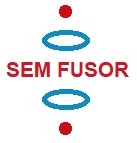|
Let's see what kind of electromagnet we need for our SEM fusor design. length: 1 mtr
diameter: 50 cm
B = 1 tesla
B =
μ0 . N/l . I (see
hyperphysics)
N= amount of
windings
l=length
μ0 = 2.10-7
N·A−2
I =
B . l /(μ0
. N)
B = 1 T, l = 1 m,
N = 1000 -> I =
1 . 1 / (2.10-7
.1000) = 5000 A , very high..
In
www.gmw.com/electromagnets
, amonst others, an electromagnet (coil) is sold: B=
0,13 T , DC power = 5,18 kW (140 A, 37 V), water cooling 12 ltr/min, 360
turns. Not exactly what we need, but just to get an idea. Not enough
magnetic field, consuming a lot of power and also very expensive .
Another example:
http://www.gmw.com/electromagnets/dipole/5503/5503.html
(30 cm gap, 140 A, 11,5 kW, 0,3 T, 16 ltr/min water cooling,
about 60000 $)
Electromagnets are usually in the form of
iron core solenoids, see
hyperphysics .
The internal magnetic domains line up and multiplicate the field by factors
to even thousands.
I think it would be better to place an
electromagnet with an inner core, on top of the fusor and under the fusor
(or if we turn it 90 º, at the sides).
In the next link a permanent magnet, with
dimensions 11x9x2 cm and a magnetic field (Remanencia Br) of 1.3 T is
sold for about 120 €, see:
https://www.supermagnete.es/imanes-bloque-neodimio/bloque-magnetico-110.6mm-x-89mm-x-19.5mm-neodimio-n45-con-recubrim-epoxi_Q-111-89-20-E
Using a couple of permanents magnets?
They seem to loose rapidly strength with the distance, see:
Fieldcalculator.asp
A small disk of 10 cm diameter and 1 cm thickness has at 1mm distance B= 1,4
tesla, but at 10 cm distance B=1,9 gauss, and at 30 cm B=0,1 gauss.
A small disk with the characteristics as in fig.1:
Fig.1a. The magnetic field of a small cylindrical neodymium magnet
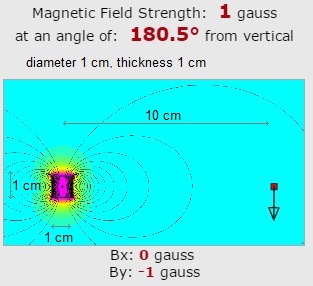
If our SEM fusor had a diameter of 20 cm and a length of 0,5 m, the
circumference would be 62 cm.
We could place 60 of this small magnets in a ring around. The magnet field
in the middle would be 60 gauss; not enough.
The price of one such small disk is about 20 $.
(
kjmagnetics.com
). One ring would cost 1200 $. 50 rings... far to
expensive.. Not an option.
A small cube of 1 x 1 x 1 cm
Fig.1b. The magnetic field of a small cubical neodymium magnet
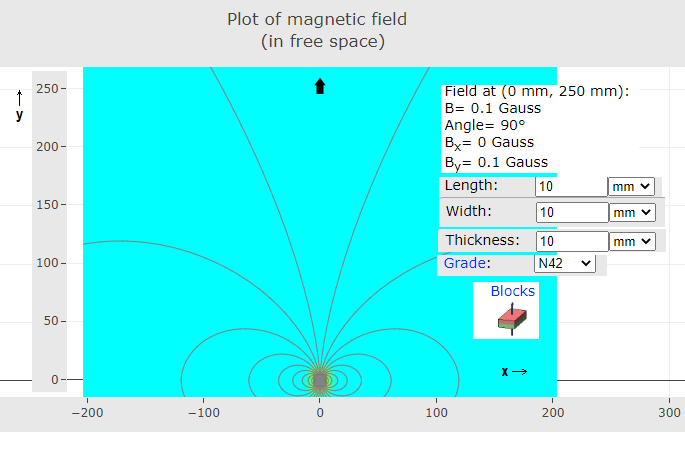
Assume we want to have a magnetic field of 0,5 T in the centre of
the vacuum chamber of the Sem Fusor which has a length of 50 cm.
0,25 T is produced by an amount of small magnets under, and 0,25 T is
produced by an amount of small magnets above the vacuum chamber.
0,25 T / (0,1 .10-4 T ) = 25000 small magnets.
In
www.supermagnete.es/imanes-bloque-neodimio
A cube of 10 x 10 x 5 mm costs 0,83 € (N42)
We would need of these about 25000 x 2 x 2 = 100 000
magnets x 0,83 € = 83 000 €
11.4 fig 1b screenshot.png
A bit expensive..
I think the best idea is to contruct a vacuum chamber with our experiment
and to look for an existing magnet in, for example, an university or
company. (universidad de Zaragoza?)
Or perhaps here?
https://ofertas.clinicpoint.com/zaragoza/offer/7577/resonancia-magnetica-de-alto-campo
(Consider the SEM fusor with a diameter of 45 cm and a length of 100 cm.
We make small electromagnets winding copper wire around a iron bold.
These electromagnets are placed around the vacuum chamber of the SEM fusor.)
Fig.2. The magnetic field of a electromagnet with an iron core
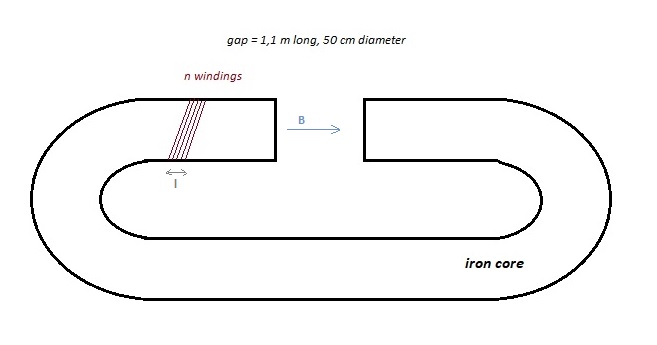
Volume of the iron core =
π (0,25)2 . 10
(for the length of the iron core we take 10 m)
= 2 m3 specific mass of iron is about 7 mt/m3
-> mass of the iron core = 14 mt
Price of iron about 1 till 3 € / kilo?
For a coil: B =
μ0 . N/l
.I
N =
amount of windings
l = length of the windings
I = current through the windings
µ0=
permeability of free space = 4π × 10−7 N·A−2
The iron core causes an increase of the magnetic field inside the coil of
about a 1000 times.
According
wikipedia.org/wiki/Electromagnet
(see also:
web.mit.edu/6.013_book/www/chapter9/9.7.html
)
(and page 706 Physics Alonso & Finn)
N. I = B
( Lcore/μ +
Lgap/μ0 ) (assuming that B in the core and
in the gap are the same, that no B (flux) is escaping, that the gap is
relatively small, L= length)
B = 1 tesla, Lgap
= 1,1 m N.I = 1. (
Lcore /
(6.3 10−3
) + 1,1 / (4π × 10−7
) ) = 8,8.105 Ampere turns.
(neglected the
Lcore /
(6.3 10−3
) term)
Engineeringtoolbox.com/permeability
- > iron 99,8% pure ->
μiron =
6.3 10−3
mkg-2C ,
μiron
/
μ0 = 5000
The length of the iron core is not so important.
Electrical cable in Bricodepot.es: 2,5 mm2 -> 0,22 € / m
According
Engineeringtoolbox.com
the maximum current of such a cable is about 20 A. ->
8,8.105 = N. 20 -> N = 44000 turns.
diameter of a turn = 60 cm -> circumference = 2π.0,3
= 1,89 m -> total length = 44000 . 1,89 m =
83 103 m - > price = 18000 € ..
Fig. 3.
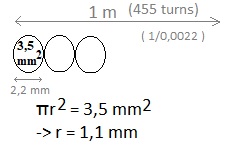
If we take into account the insulation material around the cable
(thickness of it is aproximated) and suppose the area of the cross section
is then 3,5 mm2, then we can make over 1 meter length 1 layer with 455
turns.
To get 44000 turns, we need about 100 layers. The thickness of all layers
would be around: 22 cm.
For copper the resistivity
ρ = R . A/l = 1,68 . 10-8
ohm
meter
(R
= electrical resistance, l = length, A = cross-sectional area)
Diameter vacuum chamber =
50 cm, diameter coils = about 60 cm
R =
ρ . l / A = 1,68 . 10-8 . 44000 . 2. π . 0,30 / ( 2,5
. 10-6 ) = 557 ohm
Electrical
power generated = I2
. R = 202 . 557 = 224 kW (about 200 electrical heaters of 1000 W)
Quite difficult to realize..
Back to main page
Rinze
Joustra www.valgetal.com

|
